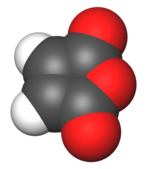| |||

| |||
| Names | |||
|---|---|---|---|
| Preferred IUPAC name
Furan-2,5-dione[2] | |||
| Other names | |||
| Identifiers | |||
3D model (JSmol)
|
|||
| 106909 | |||
| ChEBI | |||
| ChEMBL | |||
| ChemSpider | |||
| ECHA InfoCard | 100.003.247 | ||
| EC Number |
| ||
| 2728 | |||
PubChem CID
|
|||
| RTECS number |
| ||
| UNII | |||
| UN number | 2215 | ||
CompTox Dashboard (EPA)
|
|||
| |||
| |||
| Properties | |||
| C4H2O3 | |||
| Molar mass | 98.057 g·mol−1 | ||
| Appearance | White crystals or needles[3] | ||
| Odor | irritating, choking[3] | ||
| Density | 1.48 g/cm3 | ||
| Melting point | 52.8 °C (127.0 °F; 325.9 K) | ||
| Boiling point | 202 °C (396 °F; 475 K) | ||
| Reacts | |||
| Vapor pressure | 0.2 mmHg (20°C)[3] | ||
| -35.8·10−6 cm3/mol | |||
| Hazards | |||
| GHS labelling: | |||
  
| |||
| Danger | |||
| H302, H314, H317, H334, H372 | |||
| P260, P261, P264, P270, P272, P280, P285, P301+P312, P301+P330+P331, P302+P352, P303+P361+P353, P304+P340, P304+P341, P305+P351+P338, P310, P314, P321, P330, P333+P313, P342+P311, P363, P405, P501 | |||
| NFPA 704 (fire diamond) | |||
| Flash point | 102 °C (216 °F; 375 K) | ||
| Explosive limits | 1.4%-7.1%[3] | ||
| Lethal dose or concentration (LD, LC): | |||
LD50 (median dose)
|
465 mg/kg (oral, mouse) 850 mg/kg (oral, rat) 875 mg/kg (oral, rabbit) 390 mg/kg (oral, guinea pig) 400 mg/kg (oral, rat)[4] | ||
| NIOSH (US health exposure limits): | |||
PEL (Permissible)
|
TWA 1 mg/m3 (0.25 ppm)[3] | ||
REL (Recommended)
|
TWA 1 mg/m3 (0.25 ppm)[3] | ||
IDLH (Immediate danger)
|
10 mg/m3[3] | ||
| Safety data sheet (SDS) | MSDS at J. T. Baker | ||
| Related compounds | |||
Related acid anhydrides
|
Succinic anhydride | ||
Related compounds
|
Maleic acid | ||
Except where otherwise noted, data are given for materials in their standard state (at 25 °C [77 °F], 100 kPa).
| |||
Maleic anhydride is an organic compound with the formula C2H2(CO)2O. It is the acid anhydride of maleic acid. It is a colorless or white solid with an acrid odor. It is produced industrially on a large scale for applications in coatings and polymers.[5]
- ^ Merck Index, 11th Edition, 5586.
- ^ a b "Front Matter". Nomenclature of Organic Chemistry : IUPAC Recommendations and Preferred Names 2013 (Blue Book). Cambridge: The Royal Society of Chemistry. 2014. p. 835. doi:10.1039/9781849733069-FP001. ISBN 978-0-85404-182-4.
- ^ a b c d e f g NIOSH Pocket Guide to Chemical Hazards. "#0376". National Institute for Occupational Safety and Health (NIOSH).
- ^ "Maleic anhydride". Immediately Dangerous to Life or Health Concentrations (IDLH). National Institute for Occupational Safety and Health (NIOSH).
- ^ Kurt Lohbeck; Herbert Haferkorn; Werner Fuhrmann; Norbert Fedtke. "Maleic and Fumaric Acids". Ullmann's Encyclopedia of Industrial Chemistry. Weinheim: Wiley-VCH. doi:10.1002/14356007.a16_053. ISBN 978-3527306732.


